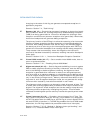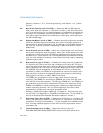
Vol. 3 2-17
SYSTEM ARCHITECTURE OVERVIEW
2.4.3 IDTR Interrupt Descriptor Table Register
The IDTR register holds the base address (32 bits in protected mode; 64 bits in
IA-32e mode) and 16-bit table limit for the IDT. The base address specifies the linear
address of byte 0 of the IDT; the table limit specifies the number of bytes in the table.
The LIDT and SIDT instructions load and store the IDTR register, respectively. On
power up or reset of the processor, the base address is set to the default value of 0
and the limit is set to 0FFFFH. The base address and limit in the register can then be
changed as part of the processor initialization process.
See also: Section 6.10, “Interrupt Descriptor Table (IDT).”
2.4.4 Task Register (TR)
The task register holds the 16-bit segment selector, base address (32 bits in
protected mode; 64 bits in IA-32e mode), segment limit, and descriptor attributes
for the TSS of the current task. The selector references the TSS descriptor in the GDT.
The base address specifies the linear address of byte 0 of the TSS; the segment limit
specifies the number of bytes in the TSS. See also:
Section 7.2.4, “Task Register.”
The LTR and STR instructions load and store the segment selector part of the task
register, respectively. When the LTR instruction loads a segment selector in the task
register, the base address, limit, and descriptor attributes from the TSS descriptor
are automatically loaded into the task register. On power up or reset of the processor,
the base address is set to the default value of 0 and the limit is set to 0FFFFH.
When a task switch occurs, the task register is automatically loaded with the
segment selector and descriptor for the TSS for the new task. The contents of the
task register are not automatically saved prior to writing the new TSS information
into the register.
2.5 CONTROL REGISTERS
Control registers (CR0, CR1, CR2, CR3, and CR4; see Figure 2-6) determine oper-
ating mode of the processor and the characteristics of the currently executing task.
These registers are 32 bits in all 32-bit modes and compatibility mode.
In 64-bit mode, control registers are expanded to 64 bits. The MOV CRn instructions
are used to manipulate the register bits. Operand-size prefixes for these instructions
are ignored. The following is also true:
• Bits 63:32 of CR0 and CR4 are reserved and must be written with zeros. Writing
a nonzero value to any of the upper 32 bits results in a general-protection
exception, #GP(0).
• All 64 bits of CR2 are writable by software.
• Bits 51:40 of CR3 are reserved and must be 0.


















